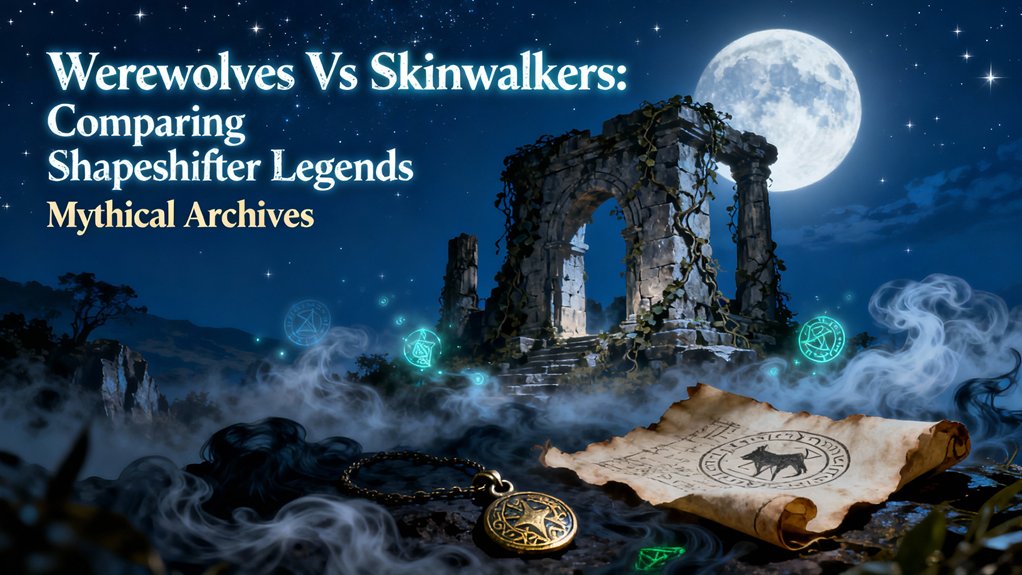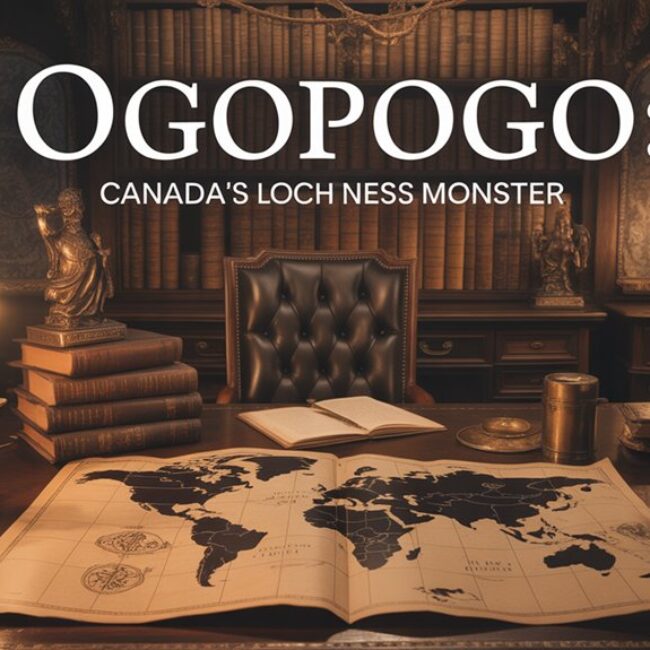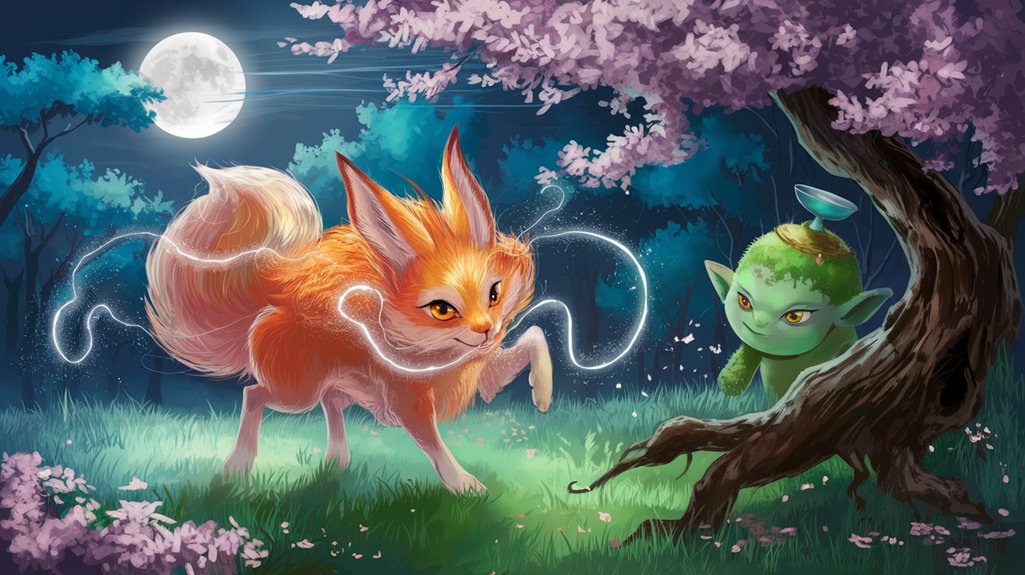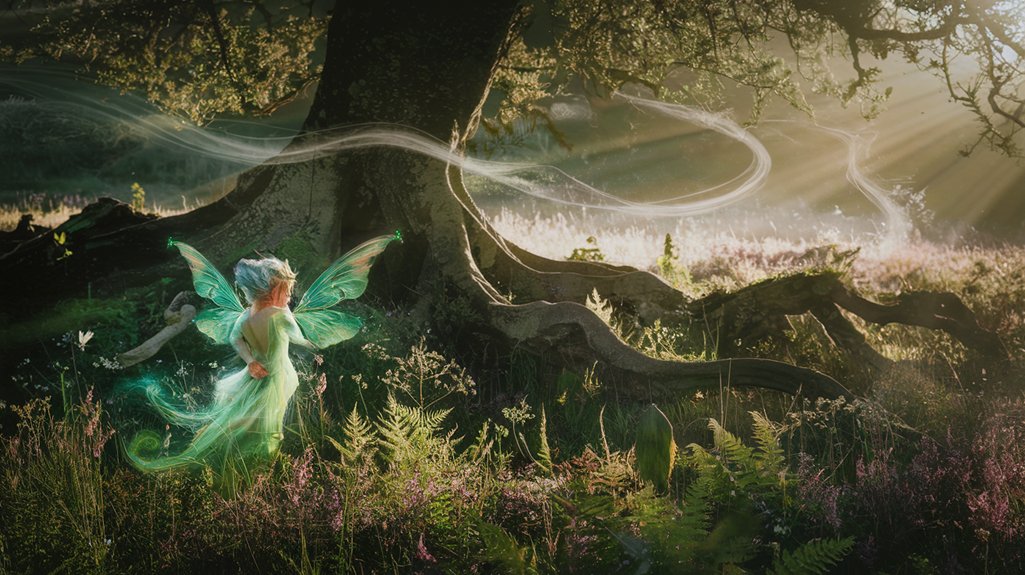Werewolves emerge from European mythology as involuntary alterations—cursed afflictions triggered by lunar cycles, documented since Petronius's *Satyricon* (circa 60 CE). Skinwalkers, conversely, represent Navajo *yee naaldlooshii*: practitioners who deliberately choose corruption through taboo violation and blood sacrifice. You'll find the former symbolizes humanity's bestial shadow and accidental monstrosity, while the latter embodies intentional moral degradation and forbidden power accumulation. This fundamental dichotomy—curse versus choice, contamination versus conscious transgression—reveals profoundly divergent cultural philosophies regarding human-animal boundaries and spiritual degradation. The distinctions extend far beyond alteration mechanics into vulnerabilities, behavioral patterns, and sacred knowledge requiring respectful engagement.
Key Takeaways
- Werewolves originate from European mythology as cursed victims, while skinwalkers are Navajo practitioners who deliberately choose corruption through taboo violations.
- Werewolves transform involuntarily during full moons, losing control to bestial instincts, whereas skinwalkers consciously shapeshift using animal pelts with maintained agency.
- Silver bullets kill werewolves by disrupting their lycanthropic curse, while exposing a skinwalker's true human identity destroys their transformative power.
- Werewolves symbolize humanity's uncontrolled primal nature, while skinwalkers represent intentional moral corruption and forbidden knowledge pursuit within Navajo cosmology.
- Discussing skinwalkers requires cultural sensitivity and community consent, as they represent protected spiritual knowledge unlike widely commodified werewolf narratives.
Origins and Cultural Roots of Each Legend
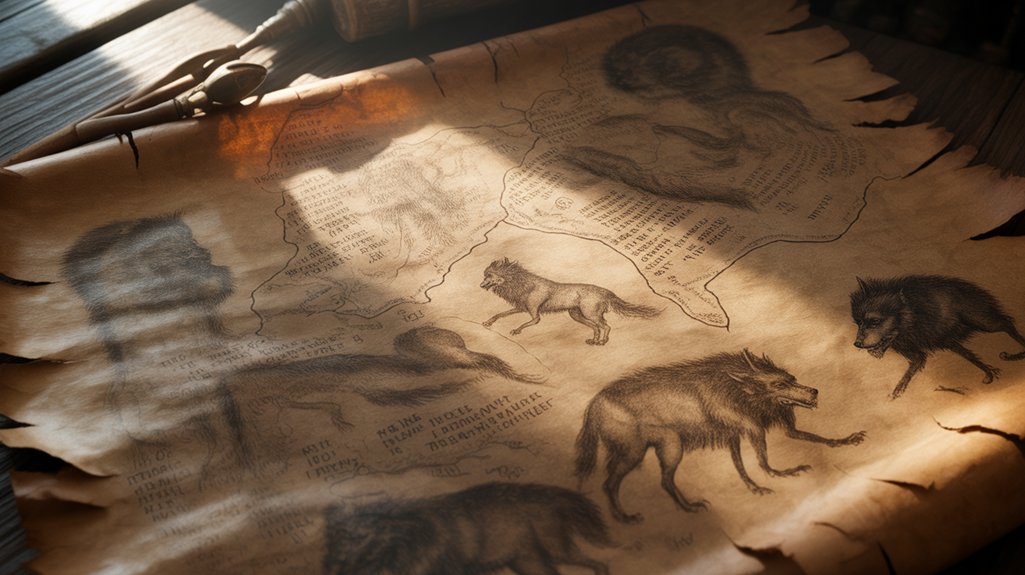
While the metamorphic beings that haunt humanity's collective memory emerge from disparate corners of the globe, they share an uncanny theological architecture—each culture's shapeshifters arising from primordial anxieties about identity, predation, and the porous boundaries between human and beast.
You'll find werewolves rooted in European soil, their mythical origins stretching back to Petronius's *Satyricon* (circa 60 CE) and earlier Greek accounts. Medieval Christianity altered them into symbols of divine punishment—lycanthropy as curse, damnation made flesh.
Skinwalkers belong to Navajo tradition exclusively. The *yee naaldlooshii*—”with it, he goes on all fours.” These aren't victims of eldritch contamination but practitioners who've chosen corruption, witches wearing chimeric pelts to accomplish malevolent purposes. Their cultural significance demands respectful distance; speaking of them invites attention.
The distinction matters. Werewolves represent involuntary alteration, European fears of losing control. Skinwalkers embody deliberate transgression, violating sacred Diné boundaries.
You're examining divergent philosophies: accidental monster versus intentional abomination.
The Nature of Transformation: Curse Versus Choice
You'll find that the fundamental distinction between werewolf and skinwalker mythologies rests upon the axis of volition—the former represents alteration as an affliction, an eldritch curse thrust upon the unwilling victim through supernatural contamination or divine retribution, while the latter embodies deliberate metamorphosis, a chimeric power consciously seized through forbidden rituals and transgressive acts.
The werewolf suffers under lunar compulsion, stripped of agency as the beast emerges; the skinwalker commands the change, donning animal pelts with full awareness and malevolent intent.
This dichotomy of curse versus choice reveals profound truths about how European and Indigenous American cultures conceptualized the boundary between human and animal, punishment and power.
Werewolf Curse Origins
The curse of lycanthropy emerges from two distinct mythological tributaries: the divine punishment and the contagion model, each carrying profound implications for how cultures have understood the boundary between human will and monstrous fate.
In werewolf mythology, Arcadia's King Lycaon suffered Zeus's wrath circa 400 BCE, altered for serving human flesh at divine feasts—a metamorphosis born of hubris, irreversible and absolute. This punishment paradigm saturates European lycanthropy history, where alteration becomes retribution for transgression.
Conversely, the contagion model—bite-transmitted curse spreading through populations like eldritch plague—emerges later, reframing lycanthropy as hereditary affliction rather than earned damnation.
You'll recognize this distinction matters profoundly: one preserves your agency through moral choice, however terrible; the other strips autonomy entirely, rendering you victim of circumstance, powerless against chimeric destiny blooming beneath your skin.
Skinwalker Voluntary Transformation
Navajo yee naaldlooshii—literally “with it, he goes on all fours”—inverts the werewolf paradigm entirely, replacing involuntary curse with deliberate profanation.
You're witnessing voluntary alteration achieved through conscious transgression: medicine people who've corrupted their sacred knowledge, practitioners who've chosen to don animal pelts—coyote, wolf, fox, crow—and merge with chimeric essence through forbidden ritual.
This isn't lunar compulsion. It's intentional shapeshifting requiring active sacrifice of taboos, the deliberate shattering of cultural boundaries that separate human from beast.
Where werewolves suffer their metamorphosis, skinwalkers *seize* it, weaponizing spiritual power meant for healing into eldritch domination.
The alteration demands preparation, ritual implements, and conscious will—freedom twisted into its darkest expression, autonomy exercised through violation of everything held sacred.
Control and Intent
Autonomy versus subjugation—this fundamental dichotomy separates alteration-by-violation from change-by-affliction across global shapeshifter taxonomies.
You'll find werewolves trapped within lunar cycles, their metamorphosis involuntary, violent, stripped of human reason. The curse operates as prison, altering flesh against will.
Skinwalkers, conversely, master intentional shapeshifting through deliberate ritual practice, maintaining consciousness throughout chimeric evolutions. They've chosen this eldritch path, wielding control mechanisms refined across generations of Navajo medicine knowledge.
Where lycanthropy enslaves, skinwalker alteration liberates—though toward darkest purposes. This distinction matters profoundly: one creature suffers damnation, losing itself to bestial impulses each moon-rise; the other commands supernatural power deliberately, retaining intent, memory, malevolence intact.
Freedom versus bondage. Choice versus compulsion. The shapeshifter who controls their form controls their destiny.
Physical Characteristics and Abilities
You've examined the metaphysical boundaries between curse and choice, but now you must confront the eldritch physicality itself—the actual change that alters human flesh into beast.
Across traditions from the Norse berserkir of 9th-century Scandinavia to the nahual sorcerers of pre-Columbian Mesoamerica, specific triggers catalyze these chimeric changes: moonlight's cold radiation, sacred pelts worn against bare skin, incantations spoken in languages older than memory.
Each tradition prescribes its own vulnerabilities—silver's alchemical purity, wolfsbane's toxic bloom, the speaking of a shapeshifter's true name—creating a taxonomy of supernatural strengths and fatal weaknesses that you must understand to grasp the full scope of these legends.
Transformation Triggers and Methods
Across the world's shapeshifter traditions, the catalysts for alteration divide into three primary categories: voluntary changes achieved through ritual mastery, involuntary shifts triggered by celestial phenomena or curses, and conditional transformations bound to specific objects or substances.
You'll find werewolves enslaved to lunar cycles, their bodies contorting beneath the full moon's eldritch pull—an affliction transmitted through infectious bite or hereditary curse.
Skinwalkers, conversely, embrace deliberate alteration rituals, donning animal pelts while invoking forbidden chants to achieve their chimeric forms.
These Navajo practitioners choose their metamorphosis through ceremonial preparation and totemic connection.
The distinction proves essential: werewolves suffer supernatural triggers beyond their control, their humanity stripped away monthly, while skinwalkers wield change as conscious power, manipulating the boundary between human and beast through deliberate, sacrilegious practice.
Freedom versus imprisonment incarnate.
Supernatural Powers and Strengths
The metamorphosis itself serves merely as a gateway—what emerges from that chrysalis of flesh and bone commands our attention now.
Werewolves possess preternatural strength, heightened senses that pierce darkness, regenerative capabilities defying mortal wounds. Their supernatural abilities remain bounded, predictable.
Skinwalkers transcend such limitations entirely. You'll find their shapeshifting powers encompass any creature they've studied—coyote, owl, crow, even human mimicry so perfect it deceives blood relatives. They manipulate minds, project voices across impossible distances, move with velocities that blur reality's edges.
The eldritch distinction proves essential: werewolves are cursed, their abilities emerging involuntarily from affliction. Skinwalkers choose their chimeric forms deliberately, wielding powers earned through forbidden Navajo ceremonies.
One suffers alteration; the other commands it. This autonomy makes skinwalkers infinitely more dangerous—and you'd do well remembering that.
Vulnerabilities and Weaknesses
Where strength manifests, vulnerability inevitably shadows—an immutable law governing all creatures caught between worlds.
You'll find these chimeric entities susceptible to distinct countermeasures rooted in their origins:
- Silver bullets pierce werewolf flesh with devastating efficacy, their lunar-blessed metal disrupting the lycanthropic alteration
- Sacred rituals and spiritual cleansing ceremonies bind Skinwalkers, forcing reversions through ancestral invocations
- Holy water burns werewolves like acid, its blessed nature rejecting their unholy change
- Protective charms crafted from healing herbs create barriers against both creatures' eldritch influence
Navajo tradition emphasizes that exposing a Skinwalker's human identity destroys their power entirely. European lore insists wolfsbane and religious symbols offer sanctuary. These vulnerabilities reflect each tradition's cosmology—Christianity versus indigenous spiritualism, material versus metaphysical warfare.
Methods of Becoming a Werewolf or Skinwalker
Throughout centuries of folklore and anthropological documentation, becoming a werewolf or skinwalker requires drastically different pathways—one often involuntary and cursed, the other deliberate and transgressive.
You'll find werewolf alteration traditionally occurs through a bite mark from another lycanthrope, transferring the curse through infected saliva beneath the full moon's eldritch light. Some European traditions describe drinking rainwater from a wolf's pawprint or consuming magical herbs mixed with lupine blood. The alteration remains involuntary—a chimeric metamorphosis you can't control.
Skinwalkers emerge through ritual initiation within Navajo culture, requiring conscious choice and profound taboo violation. You must perform blood sacrifice of a close relative, donning the animal skin of your chosen form while speaking forbidden incantations. This isn't accidental curse but deliberate spiritual corruption.
Unlike the werewolf's involuntary curse, skinwalker transformation demands deliberate evil—ritualized murder and forbidden acts that irrevocably corrupt the practitioner's soul.
The distinction crystallizes clearly: werewolves become monsters through fate or misfortune, while skinwalkers choose darkness through calculated transgression, abandoning their humanity for malevolent power over sacred boundaries.
Behavioral Patterns and Motivations

Hunger drives these creatures along divergent paths—werewolves succumb to bestial instinct, while skinwalkers weaponize alteration for calculated harm.
Shapeshifter psychology reveals fundamental differences in their eldritch motivations. You'll find werewolves trapped in cyclical alterations, their primal instincts overwhelming human consciousness during lunar peaks. They hunt without premeditation, driven by carnivorous needs that eclipse rational thought.
Skinwalkers operate from malevolent intention, their chimeric forms serving specific aims:
- Territorial dominance over rivals and communities
- Retribution against perceived enemies through supernatural assault
- Accumulation of power through forbidden ceremonial practices
- Psychological warfare designed to induce fear and chaos
The werewolf's curse manifests as involuntary surrender to animalistic urges—you're witnessing possession by lunar forces beyond conscious control. Conversely, skinwalkers maintain agency throughout alteration, their human wickedness amplified rather than replaced.
This distinction separates involuntary affliction from deliberate corruption, marking one tradition as tragic alteration, the other as chosen descent into darkness.
Vulnerabilities and Ways to Defeat Them
Silver's legendary potency against werewolves stems from the metal's association with lunar purity and divine protection across European alchemical traditions.
Yet you'll discover this defense proves utterly ineffective against skinwalkers. Where silver bullets pierce lycanthropic flesh with devastating efficacy, these chimeric Navajo entities require entirely different countermeasures rooted in Indigenous spiritual frameworks.
Silver's mastery over werewolves finds no purchase against skinwalkers, whose vulnerabilities exist within entirely separate ceremonial domains beyond European tradition.
You'll need ritualistic cleansing through Enemyway ceremonies, performed by recognized medicine practitioners who possess the eldritch knowledge to reverse yee naaldlooshii corruption.
Sacred herbs—particularly white ash from lightning-struck trees—create protective barriers these shapeshifters can't penetrate.
Your survival depends on protective talismans blessed through proper ceremonial channels, respecting protocols outsiders rarely access.
The werewolf's vulnerability lies in metallurgy and folklore; the skinwalker's exists within sacred ceremonial systems you can't simply appropriate.
These aren't superstitions you can weaponize freely—they're living practices demanding cultural authorization, spiritual preparation, and profound respect for traditions spanning centuries.
Cultural Significance and Spiritual Meaning
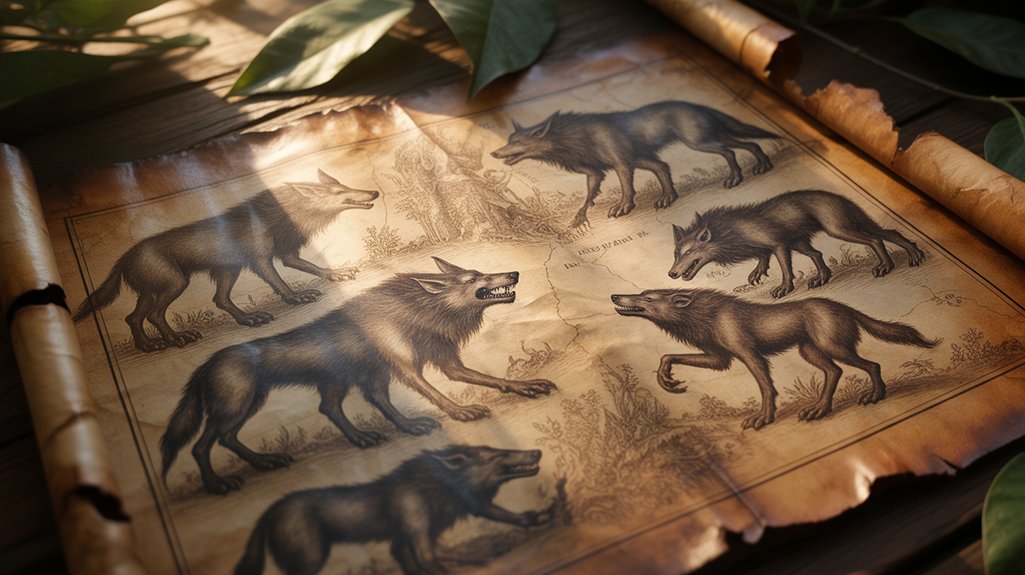
Beyond mere defensive protocols and supernatural vulnerabilities, these shapeshifter traditions embody fundamentally divergent cosmological architectures—werewolf mythology reflecting European anxieties about civilization's fragile boundaries, skinwalker beliefs encoding Navajo ethical frameworks regarding power's corruption.
You'll discover profound cultural symbolism woven through each tradition:
- Werewolves: Represent humanity's bestial shadow, the eldritch alteration manifesting uncontrolled rage and societal transgression.
- Skinwalkers: Embody deliberate moral degradation, practitioners choosing forbidden knowledge over communal harmony.
- European context: Lycanthropy symbolizes medieval fears of wilderness encroaching upon ordered Christian society.
- Navajo framework: Yee naaldlooshii violations demonstrate consequences when individuals pursue power through taboo-breaking ceremonies.
The spiritual significance differs fundamentally. Werewolves exist as cautionary metaphors, chimeric warnings about losing one's humanity.
Skinwalkers operate within living Indigenous belief systems, representing actual spiritual dangers requiring ceremonial protection.
European legends became folklore; Navajo traditions remain sacred, protected knowledge demanding your respectful distance.
Modern Representations in Popular Culture
Skinwalkers occupy darker territory. Their representation remains controversial—Navajo communities actively resist Hollywood's appropriation of yee naaldlooshii traditions.
Unlike werewolves, skinwalkers resist commodification—Navajo communities protecting sacred traditions from entertainment industry exploitation and misrepresentation.
When television series attempt portrayal, they typically dilute the profound spiritual alteration into generic monster fare.
You're witnessing cultural tension: werewolves freely converted into entertainment, while skinwalkers demand respectful distance.
This disparity reveals power relationships—European folklore becomes universal property, Indigenous sacred knowledge fights exploitation.
Modern adaptations illuminate which traditions society claims, which remain protected.
Respectful Engagement With Indigenous Beliefs

When approaching traditions that remain sacred to living communities, you're entering ceremonial ground where academic curiosity must yield to cultural sovereignty.
Cultural sensitivity demands recognition that skinwalker narratives aren't merely folklore—they're protected spiritual knowledge carrying genuine weight within Navajo cosmology.
Indigenous perspectives reveal eldritch realities Western frameworks can't adequately contain. You'll encounter boundaries deliberately maintained:
- Ceremonial knowledge exists outside public discourse, safeguarded through generations of oral tradition.
- Speaking certain names invites malevolent attention, violating protocols that predate colonial contact.
- Academic extraction mirrors historical theft, commodifying sacred wisdom for entertainment consumption.
- Living practitioners navigate these chimeric forces daily, not as mythology but lived experience.
Your fascination doesn't grant access. Respectful engagement means accepting limitations, consulting tribal authorities, and prioritizing community consent over content creation.
Some mysteries remain intentionally veiled—not from ignorance, but from wisdom understanding certain thresholds shouldn't be crossed. True freedom includes honoring others' sovereignty over their spiritual heritage.
Frequently Asked Questions
Can Werewolves and Skinwalkers Coexist in the Same Geographic Region?
You'll find these entities can absolutely coexist—their cultural perceptions rarely overlap in practice.
European werewolf legends and Navajo skinwalker traditions occupy distinct spiritual territories, even when regional folklore geographically intersects.
The werewolf emerges from Germanic and Mediterranean consciousness, evolving through curse or moon's eldritch pull.
The yee naaldlooshii walks through Diné sacred knowledge, a chimeric corruption of healing ways.
Different cosmologies. Different rules.
Both claim the liminal darkness, yet they hunt through separate mythological frameworks, never truly crossing paths.
Are There Documented Cases of People Claiming to Be Shapeshifters?
You'll find documented testimonies throughout history—shamanic practitioners in Siberia, Nordic berserkers, Indigenous medicine workers—each claiming authentic alteration.
Shapeshifter folklore reveals this chimeric truth: cultural variations determine what's confession versus sacred calling.
In 1692 Livonian werewolf trials, Thiess claimed righteous shapeshifting to battle witches.
Navajo accounts, though protected, acknowledge practitioners who've crossed forbidden boundaries.
These aren't mere myths you're reading; they're ancestral testimonies from liminal spaces where flesh remembers its eldritch potential for change, waiting.
Do Werewolf and Skinwalker Legends Share Any Common Historical Origins?
You'll find no direct historical lineage between these traditions—they emerged independently from distinct cultural influences.
European werewolf lore, rooted in Greco-Roman lycanthropy and medieval Christianity, evolved separately from Navajo yee naaldlooshii beliefs.
Yet mythological parallels exist: both manifest humanity's eldritch fascination with chimeric alteration, forbidden power obtained through transgression.
These aren't borrowed narratives but convergent expressions of universal fears regarding boundary-violation between human and beast.
Independent origins. Shared human terrors.
Can Someone Be Both a Werewolf and a Skinwalker Simultaneously?
Could you truly embody two eldritch changes simultaneously?
You can't merge werewolf characteristics—involuntary lunar alteration, cursed affliction—with skinwalker abilities rooted in deliberate Navajo witchcraft practices.
These traditions occupy separate cosmological frameworks: European lycanthropy binds you through contagion or heredity, while yee naaldlooshii status demands conscious transgression, donning specific pelts.
The chimeric fusion you're imagining violates both mythological structures. Each path alters your essence differently, incompatibly.
You'd walk neither domain authentically.
Which Shapeshifter Legend Is Older in Recorded Human History?
You'll find werewolf legends predating skinwalker traditions in ancient texts by millennia.
Lycanthropy appears in Mesopotamian epics like the Epic of Gilgamesh (circa 2100 BCE) and Greek mythology's Arcadian tales.
These eldritch alterations possessed profound cultural significance across Mediterranean civilizations.
Skinwalker beliefs, while equally potent, emerged from Navajo tradition—comparatively recent in recorded history.
The werewolf's chimeric legacy consequently claims greater antiquity, though both shapeshifter paths command reverence as living spiritual knowledge demanding freedom from dismissive modern skepticism.
Conclusion
You've journeyed through these eldritch traditions, witnessed how curse diverges from covenant, how European folklore contrasts with Diné sacred knowledge. Both legends pulse through our collective consciousness like WiFi signals—invisible yet omnipresent, connecting past to present. The werewolf's chimeric form represents humanity's bestial shadow. The skinwalker embodies spiritual transgression's terrible cost. These shapeshifters aren't mere entertainment. They're ancestral warnings, liminal guardians teaching respect for boundaries we shouldn't cross.
